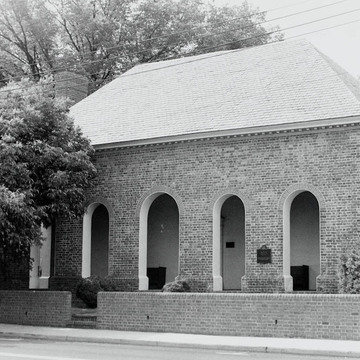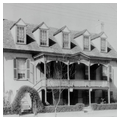Because there were few concentrated centers of population in the plantation economy, many counties found it simply uneconomical to construct permanent brick courthouses, and the courts met in makeshift quarters. For nearly a century after its establishment, this was the case with the county of Isle of Wright. Finally, in 1749 Colonel Arthur Smith donated land for the new town of Smithfield and provided lots within the town to build a new courthouse. In 1749 the court ordered the new courthouse and further stipulated that “John Willis and William Hodseden, gentlemen apply to some undertaker to Prepare a Plan for the said building.” William Rand was the builder, or undertaker.
A T-shaped brick structure with a five-bay front arcade and a rear apse, the Isle of Wight courthouse is one of about a half dozen courthouses built in eighteenth-century Virginia to have such features. The brickwork is fine, with rubbed bricks for the arcade and Flemish bond above the English bond water table. Both the arcade, or “piazza,” as it is also called, and the apse can be traced as public building design elements to the first capitol in Williamsburg. Both features also have an earlier history in English public buildings—in town halls and market houses erected in the century following the Restoration. In Virginia the arcade served as a place for court participants and spectators to gather before entering directly into the courtroom and provided a symbolic face to what would otherwise have been a very domestic-looking structure. The center arch is larger than the flanking arches. At the back of the courtroom stood a raised magistrates' platform very similar to the one in the Williamsburg courthouse. So that the magistrates could communicate with one another the bench curved in a semicircle. In a feature absent from the Williamsburg









